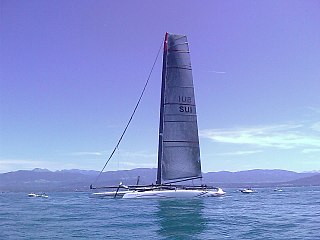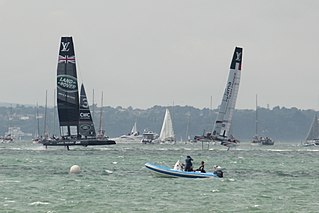
A catamaran is a watercraft with two parallel hulls of equal size. The distance between a catamaran's hulls imparts resistance to rolling and overturning. Catamarans typically have less hull volume, smaller displacement, and shallower draft (draught) than monohulls of comparable length. The two hulls combined also often have a smaller hydrodynamic resistance than comparable monohulls, requiring less propulsive power from either sails or motors. The catamaran's wider stance on the water can reduce both heeling and wave-induced motion, as compared with a monohull, and can give reduced wakes.

Oracle Team USA is an American yacht racing syndicate initially formed to compete for the 2003 America's Cup. They competed again in the 2007 event before winning the 33rd America's Cup regatta in 2010 – representing the Golden Gate Yacht Club. The team also won the 34th America's Cup in 2013.

The International Americas Cup Class is a class of racing yacht that was developed for the America's Cup between 1992 and 2007. These yachts, while not identical, were all designed to the same formula to offer designers the freedom to experiment whilst keeping the boats sufficiently comparable to race in real time. The class was established for the 1992 America's Cup because of perceived shortcomings of the 12-metre class, which had been used in the America's Cup since 1958.
Team New Zealand or TNZ is a sailing team based in Auckland, New Zealand representing the Royal New Zealand Yacht Squadron.

A sailing hydrofoil, hydrofoil sailboat, or hydrosail is a sailboat with wing-like foils mounted under the hull. As the craft increases its speed the hydrofoils lift the hull up and out of the water, greatly reducing wetted area, resulting in decreased drag and increased speed. A sailing hydrofoil can achieve speeds exceeding double and in some cases triple the wind speed.
Luna Rossa Prada Pirelli, originally named Prada Challenge, then Luna Rossa Challenge, is an Italian sailboat racing syndicate first created to compete for the 2000 America's Cup. It won the Louis Vuitton Cup on its first attempt in 2000, but then lost the America's Cup match against the defending champion team, Team New Zealand.

USA-17 is a sloop rigged racing trimaran built by the American sailing team BMW Oracle Racing to challenge for the 2010 America's Cup. Designed by VPLP Yacht Design with consultation from Franck Cammas and his Groupama multi-hull sailing team, BOR90 is very light for her size being constructed almost entirely out of carbon fiber and epoxy resin, and exhibits very high performance being able to sail at 2.0 to 2.5 times the true wind speed. From the actual performance of the boat during the 2010 America's Cup races, it can be seen that she could achieve a velocity made good upwind of over twice the wind speed and downwind of over 2.5 times the wind speed. She can apparently sail at 20 degrees off the apparent wind. The boat sails so fast downwind that the apparent wind she generates is only 5-6 degrees different from that when she is racing upwind; that is, the boat is always sailing upwind with respect to the apparent wind. An explanation of this phenomenon can be found in the article on sailing faster than the wind.

Alinghi 5 is a 90 ft (27 m) (LWL), 90 ft (27 m) beam sloop-rigged catamaran built by Alinghi for the 33rd America's Cup.

High-performance sailing is achieved with low forward surface resistance—encountered by catamarans, sailing hydrofoils, iceboats or land sailing craft—as the sailing craft obtains motive power with its sails or aerofoils at speeds that are often faster than the wind on both upwind and downwind points of sail. Faster-than-the-wind sailing means that the apparent wind angle experienced on the moving craft is always ahead of the sail. This has generated a new concept of sailing, called "apparent wind sailing", which entails a new skill set for its practitioners, including tacking on downwind points of sail.

The 34th annual America's Cup was a series of yacht races held in San Francisco Bay in September 2013. The series was contested between the defender Oracle Team USA team representing the Golden Gate Yacht Club, and the challenger Emirates Team New Zealand representing the Royal New Zealand Yacht Squadron. The format was changed radically to a best of 17, and Oracle Team USA defended the America's Cup by a score of 9 to 8 after Team New Zealand had built an 8 to 1 lead. Team New Zealand won the right to challenge for the Cup by previously winning the 2013 Louis Vuitton Cup. The 34th America's Cup's race schedule was the longest ever, in terms of number of days and number of races, and the first since the 25th America's Cup to feature both teams in a match point situation.

The 2017 America's Cup was the 35th staging of the America's Cup yacht race. The challenger, Emirates Team New Zealand, won by a score of 7 to 1 over the defender, Oracle Team USA. It was held on the Great Sound in Bermuda from June 17 to June 26. The races were conducted using hydrofoiling AC50 America's Cup Class yachts, which are slightly larger than the AC45F yachts used in the 2015–16 America's Cup World Series.

The AC50 was a wingsail catamaran development rule that governed the construction of the yachts used in the 2017 Louis Vuitton Cup and the 2017 America's Cup. Like the larger AC72s used in the 2013 America's Cup, AC50s used L-shaped daggerboard stabilizers as well as T-shaped rudder elevators that were able to generate enough lift to allow the boats to exit displacement mode in winds in excess of 7kt. Prototype versions of crossbeams, wingsails, appendages, as well as steering and trimming systems had been tested by all syndicates on AC45 platforms as surrogate yachts before building their AC50. The class allowed hydraulic control of the wingsails and appendages. Motors and computer automation was banned in the class. Each challenger team was only allowed to build one AC50 for competition and only six boats were built. The class was replaced with the monohull AC75 after the 2017 America's Cup.
The 2017 Louis Vuitton Challenger's Trophy was a sailing competition held to determine the challenger in the 2017 America's Cup.

The America's Cup World Series are match races and fleet regattas used as heats for the 2013 America's Cup and the 2017 America's Cup.

Aotearoa is an AC72 class catamaran of Emirates Team New Zealand that unsuccessfully challenged for the 2013 America's Cup. It was built for Emirates Team New Zealand for the 2013 Louis Vuitton Cup.

The GC32 is a class of hydrofoiling catamaran, 32 feet in length and constructed of carbon fibre, with a top speed of about 40 knots. They are sailed in the GC32 Racing Tour, and have replaced the Extreme 40's in the Extreme Sailing Series.

INEOS Britannia is a British sailing team that is the challenger of record for the 37th America's Cup.
Stephen John Barclay is a New Zealander who has worked in the real estate business as well as the government sector, and who was the CEO of the America's Cup Event Authority for the 34th America's Cup in 2013 during the inauguration of the AC72 wing-sail catamarans. Barclay was a member of the 2010 America's Cup winners, BMW Oracle Racing. Barclay is a former Oracle Team USA chief operating officer and was also a director of Core Builders Composites a 100 per cent-owned subsidiary of Oracle in Warkworth, New Zealand. Core Builders produced the 40m-high wingsails for the AC72 and AC45 boats. Barclay stressed in an op-ed the nature of the event:
The Cup is a medium-size business, employing over 100 people, with tens of millions of dollars a year in revenues and expenses.

Artemis Racing is a professional sailing team founded in 2006 by businessman and sailor Torbjörn Törnqvist, named after Artemis, the ancient Greek goddess.













